Colt is back.
I can’t tell you how much it pleases me to write that!
There was a time, not long ago, when the Rampant Pony had been stabled and it looked like the vet would be putting it down soon. In the early 1990s, the company made a deliberate decision to focus on military contracts, and in the process, they virtually abandoned the commercial market. The only new Colts you were likely to find in your local gun shop were AR-15 variants and a rare 1911 that dripped out of a faucet that someone had failed to shut off all the way. There was a nasty rumor going around that the Custom Shop was still making Single Action Army models, but I didn’t know anyone who actually saw one in the wild.

The company changed hands a few times, and there were bankruptcies. Since emerging from the latest one in January 2016, Colt has been working hard to recapture a portion of the commercial market, and with gun guys like Paul Spitale helping to guide the effort, things are looking much better now for the iconic American company. There are still challenges to deal with, but the revitalized commercial division now has a chance to help lead Colt towards a better future.
A major part of this recovery is an improved and expanded catalog. In contrast to the stagnation that characterized the company for decades, we’ve seen a flurry of exciting new revolvers from Colt, to include the excellent King Cobra, the Diamondback-like King Cobra Target, and the long awaited Python. We’ve been really impressed by the energy and products from the good people in Hartford, lately.
An unexpected surprise
This revolver renaissance kicked off just a few years ago, in 2016. It was in the final month of that year that Colt caught all of us flat-footed with media announcements discussing a new revolver that would debut at the 2017 SHOT Show, just a few weeks later. For RevolverGuys like me, who remembered the times before the long Colt blackout, it was difficult to wait until SHOT Show finally rolled around, to get our first look at this new, rotating Colt.
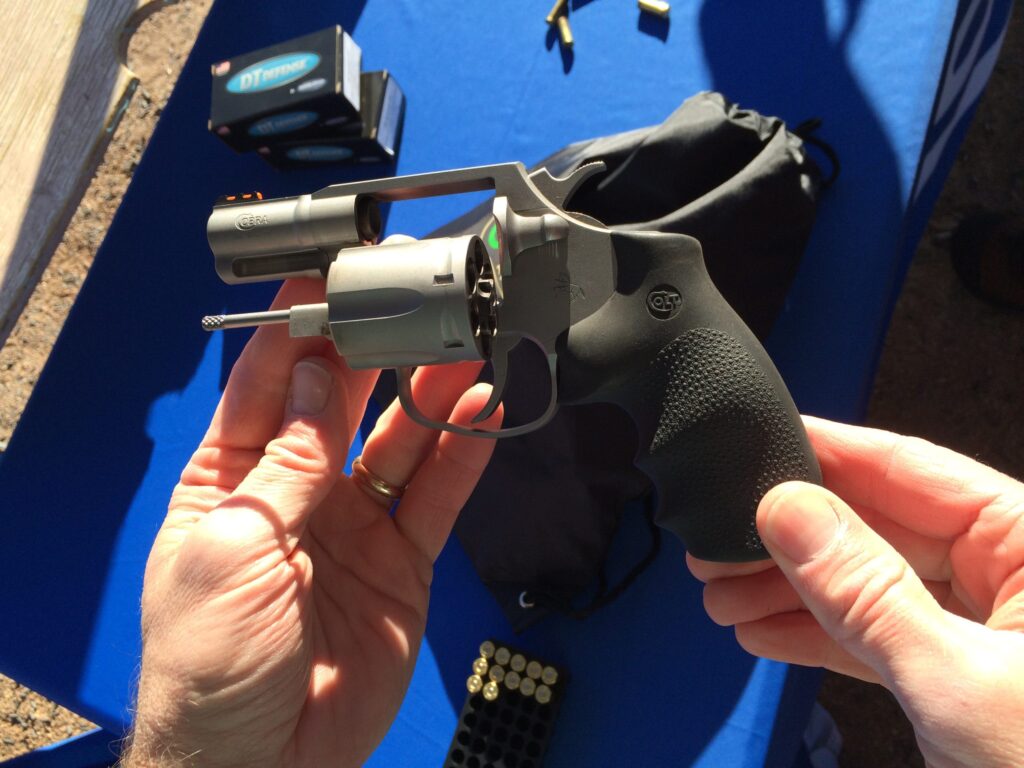
What Colt had waiting for us was the new version of the Cobra revolver. I have to specify “new version,” because the “Cobra” name was recycled from Colt’s legendary past, where it represented a very different revolver than this new product. (1) The original Cobra was essentially an aluminum-framed model of the wildly popular Detective Special, which shaved about seven ounces off the weight of the all-steel gun. It was a market leader, and arch rival Smith & Wesson scrambled to produce their own aluminum-framed compact, the Chief’s Special Airweight, to catch up. The original Cobra was built from about 1950 to 1981, and has the distinction of being the first “snake” in the Colt family. (2)
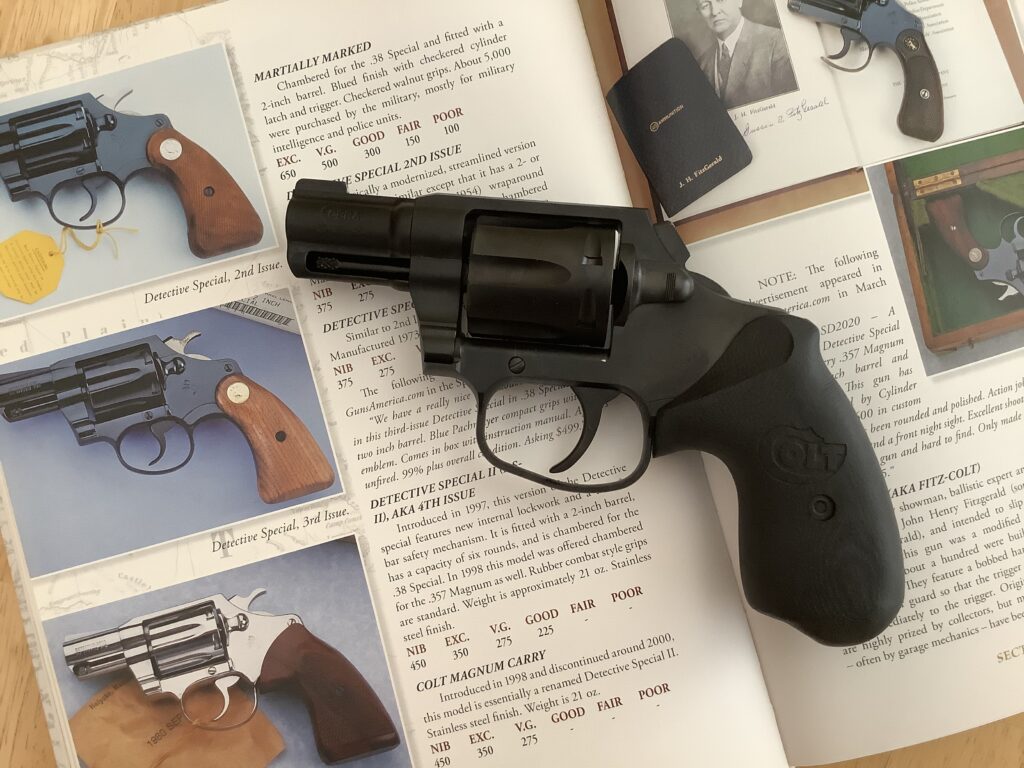
Differences
The new (2017) Cobra differed from the old in several meaningful ways. To begin with, the new Cobra featured a frame and cylinder made from stainless steel, which bumped the weight up about 10 ounces, to a nominal 25 ounces curb weight (vice 15 for the original). It also featured a replaceable front sight (secured with an Allen screw, and easily removed with a wrench—thank goodness they didn’t use a pin that had to be drifted!), instead of an integral one milled as part of the barrel.
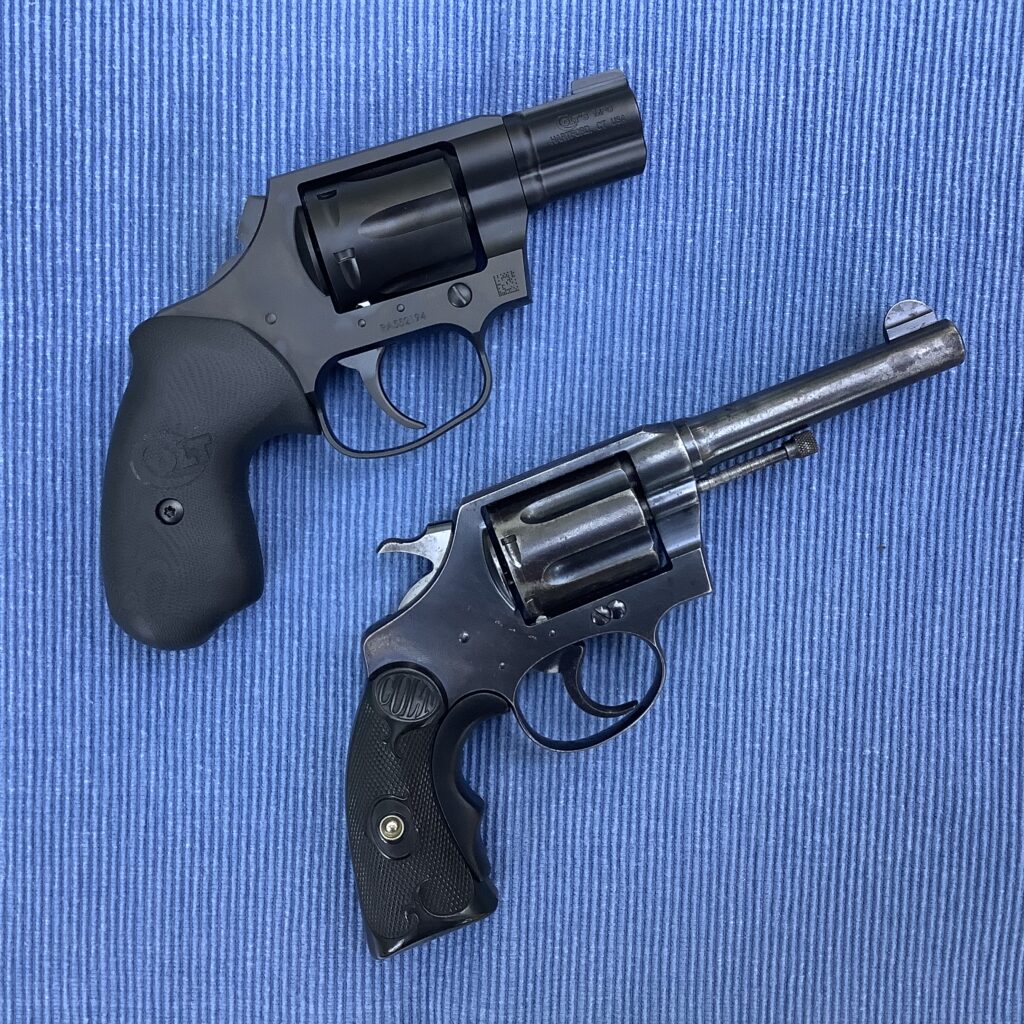
The new Cobra had a redesigned grip frame and trigger guard, as well. On the new Cobra, the trigger guard was both larger and elongated, to provide more clearance inside (a help for gloved fingers). The grip frame was slightly reshaped to alter the angle that the trigger finger approached the trigger face, allowing the trigger finger to move to the rear in more of a straight line. Additionally, there was more space between the front of the grip frame and the rear of the trigger guard.
In keeping with modern manufacturing practices, the new Cobra used metal-injection-molding (MIM) parts instead of forged ones to keep costs down. The trigger and hammer, for example, are MIM parts on the new Cobra, and bear some mold marks as proof.
Under the hood
The new Cobra featured an action that was patterned after the SF-VI / DS-II, instead of the original Cobra. The SF-VI action was a modified version of the Trooper Mk III action (created by Dick Baker) that incorporated a V-mainspring (similar to, but not the same, as the one found on the older D-Frames), instead of the Trooper Mk III’s coil mainspring.
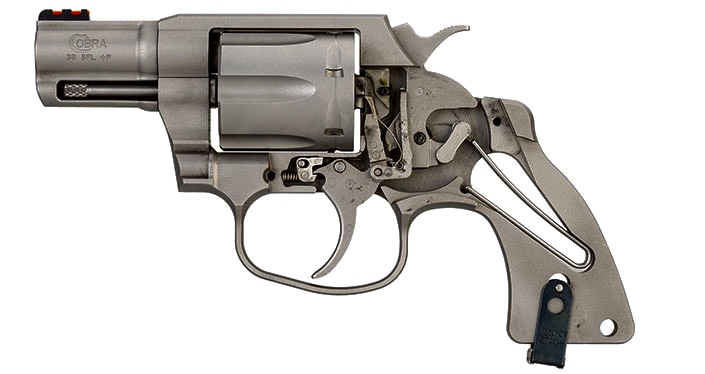
Salient features of the new Cobra action include:
-A frame-mounted firing pin and transfer bar system, like that found on the Trooper Mk III and SF-VI (the original Cobra had a hammer-mounted firing pin and a trigger-actuated hammer block that would lower when the trigger was pulled);
-A hand that is powered by a flat spring on the transfer bar, like the Mk III and SF-VI, instead of a mainspring-tensioned rebound lever (as in the original Cobra);
-A cylinder bolt that is powered by a robust coil spring in the fore-aft axis, instead of a smaller coil spring in the vertical axis (as in the original Cobra) or a torsion spring (as on the SF-VI and Mk III, which was also very strong, but perhaps took up more space than a coil);
-A small, V-shaped, torsion-style spring with two short legs to power the trigger return (as on the SF-VI), instead of a straight torsion spring with a long leg and a short leg (as on the Mk III), or a mainspring-tensioned rebound lever (as in the original Cobra);
-A V-shaped mainspring (actually, more of a “U”) that powers the hammer only, like on the SF-VI (in the original Cobra, the V-spring also powered the rebound lever, which is absent on the SF-VI and new Cobra. The Mk III used a coil mainspring instead of a V-spring);
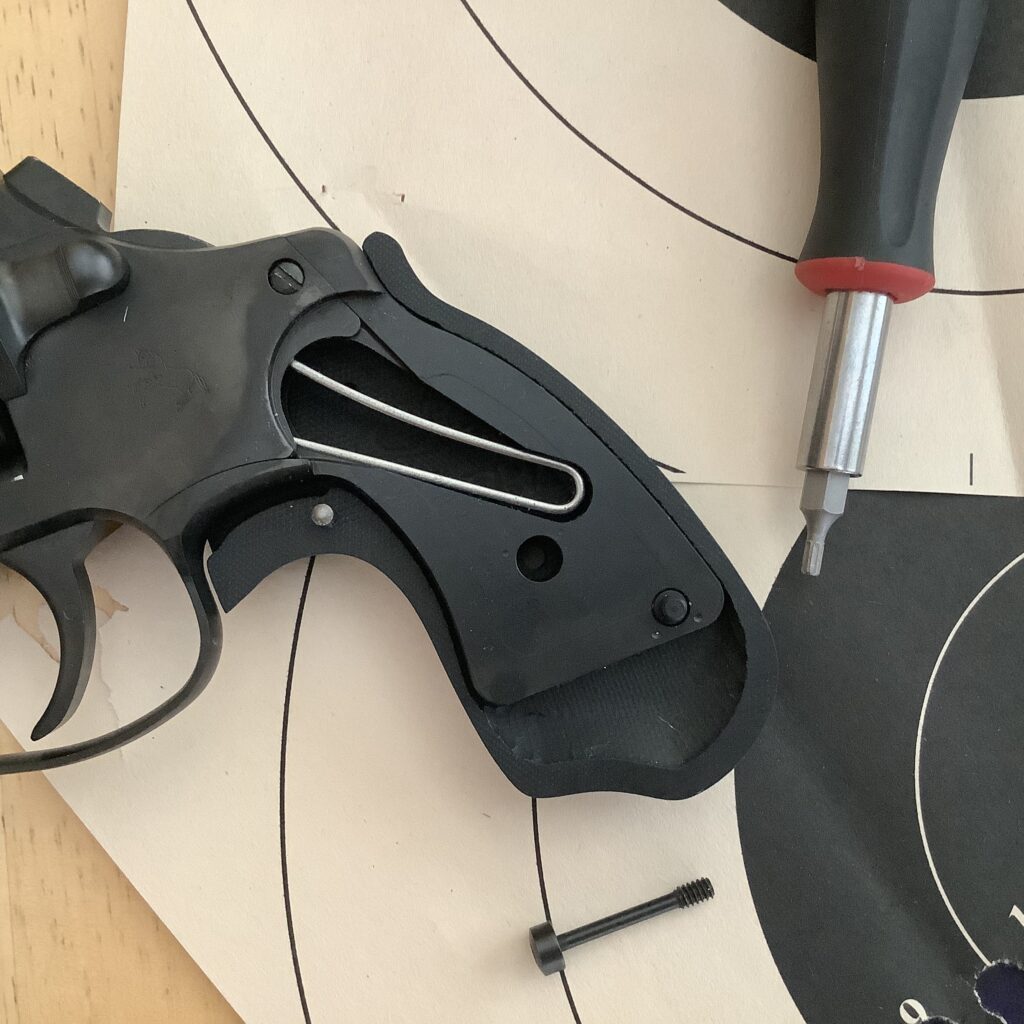
So, what’s the sum total of all this? The new Cobra action is more robust and less expensive to manufacture than the old Cobra action. It doesn’t require hand fitting by experienced craftsmen who understand the complex, Rube Goldberg-type geometry of the old-style Colt action, and the parts are less likely to wear and require frequent tuning or replacement. The U-style (soft-V-style?) mainspring gives the trigger its characteristic Colt “stacking” feel, in homage to the original D-Frames that the new Cobra traces its roots to.
Right hand drive
The new Cobra, like the Colts that came before it, has a cylinder that rotates clockwise (or to the right), as viewed from the rear. The cylinder bolt locks up the cylinder quite late in the firing cycle, in typical Colt fashion. In fact, it doesn’t really lock the cylinder into position until just before the hammer starts to fall. This is different than the Smith & Wessons, which lock things up solidly, well before the trigger has stopped moving to the rear (S&W shooters know this as the point where they might “stage” the trigger, if they manipulate the trigger like that). Honestly, delaying the lockup like this is a risky proposition from a design standpoint, since it doesn’t take much in the way of wear or stacking tolerances before a system like this can get out of time. If it does, the gun will fire before the cylinder locks up, and will beat itself to death. Fortunately, the new Cobra has a much stronger spring powering its bolt, which should help to preserve the system better.
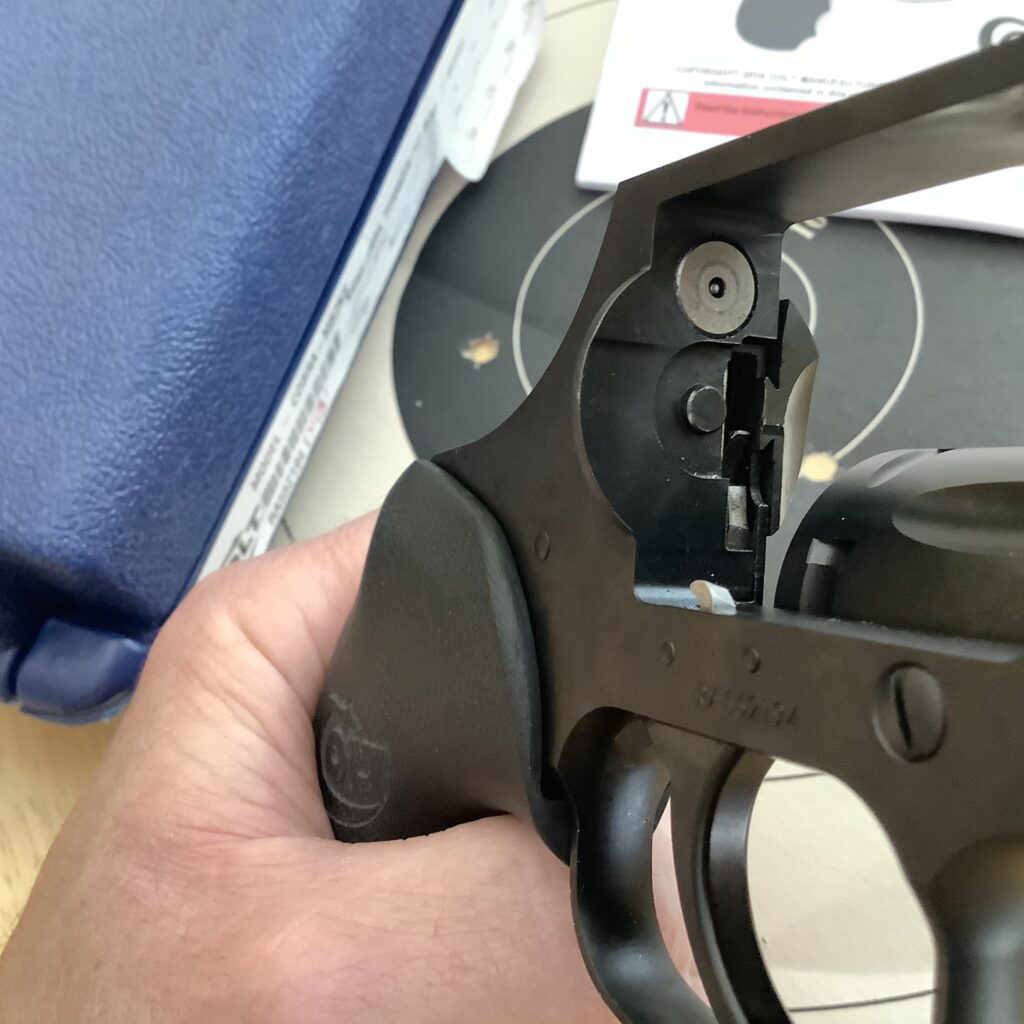
The hand on the new Cobra engages the ratchet in a similar fashion to the old, with two contact surfaces. The upper hook engages the ratchet first and starts to turn the cylinder, then the lower hook picks up the next ratchet tooth below, to help finish the job. When the sear releases at the end of the trigger stroke, the bolt has just locked up the cylinder, and the hand is binding on the ratchet in two different locations, pushing the cylinder slightly forward. It’s this contact between the hand and ratchet which leads to the hand wearing in the older Colts, when the cylinder is slammed to the rear by recoil. This, in turn, makes them go out of time rather quickly. The new Cobra will likely experience some of this too, but the hand on the new gun is much easier to replace if it wears, and since it’s harder, it probably won’t wear as quickly as the older ones did.
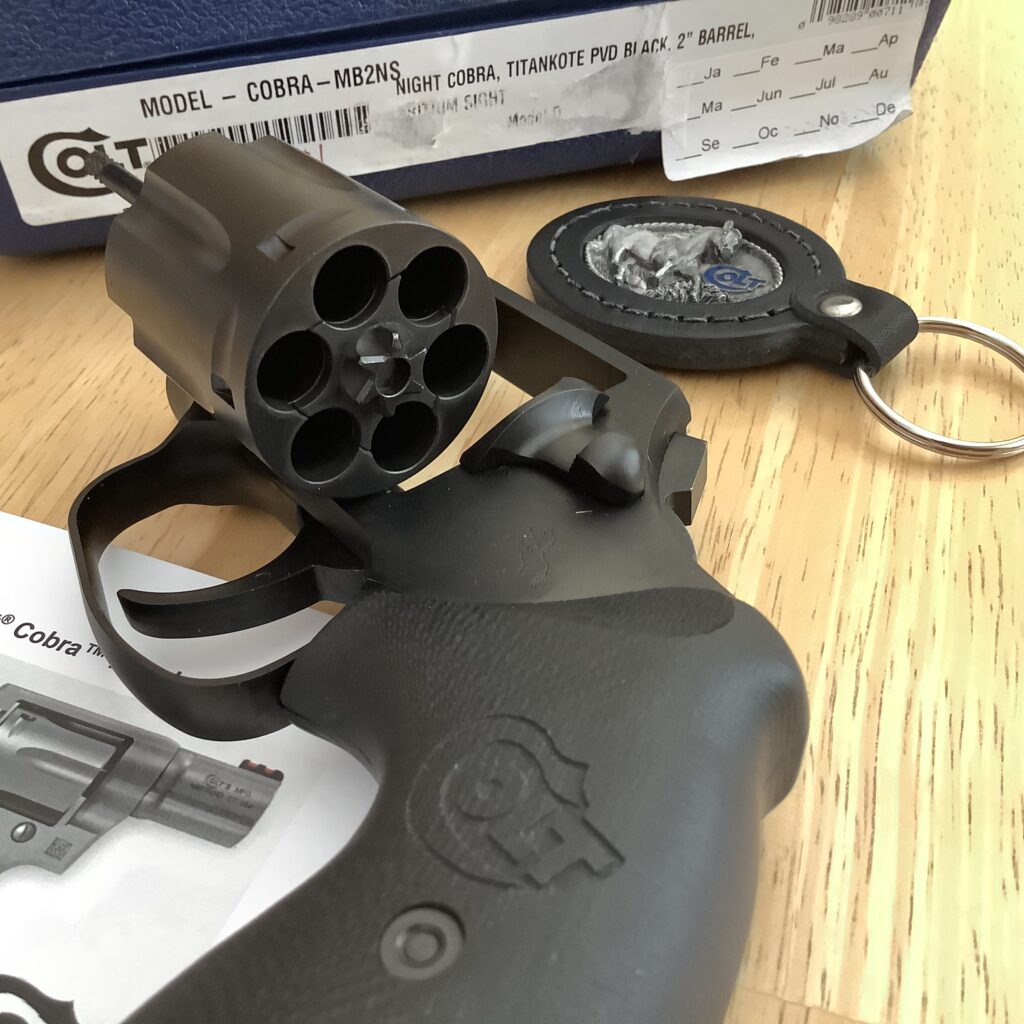
The cylinder release, like all Colts, operates by pulling it to the rear, instead of pushing it forward, as in the S&W system. It’s a very natural motion, and if you use a technique like Grant Cunningham’s Universal Revolver Reload, you don’t have to spend any mental energy trying to remember which way it goes.
Things that go bump
The new Cobra was a success for Colt, and got them back into the revolver business in a big way. As interest in the gun increased, consumers started asking Colt for new models with different features, because we always want what’s not in the catalog, right?
The Night Cobra under consideration here is a new Cobra with upgrades designed to make it an even better gun for concealed carry.
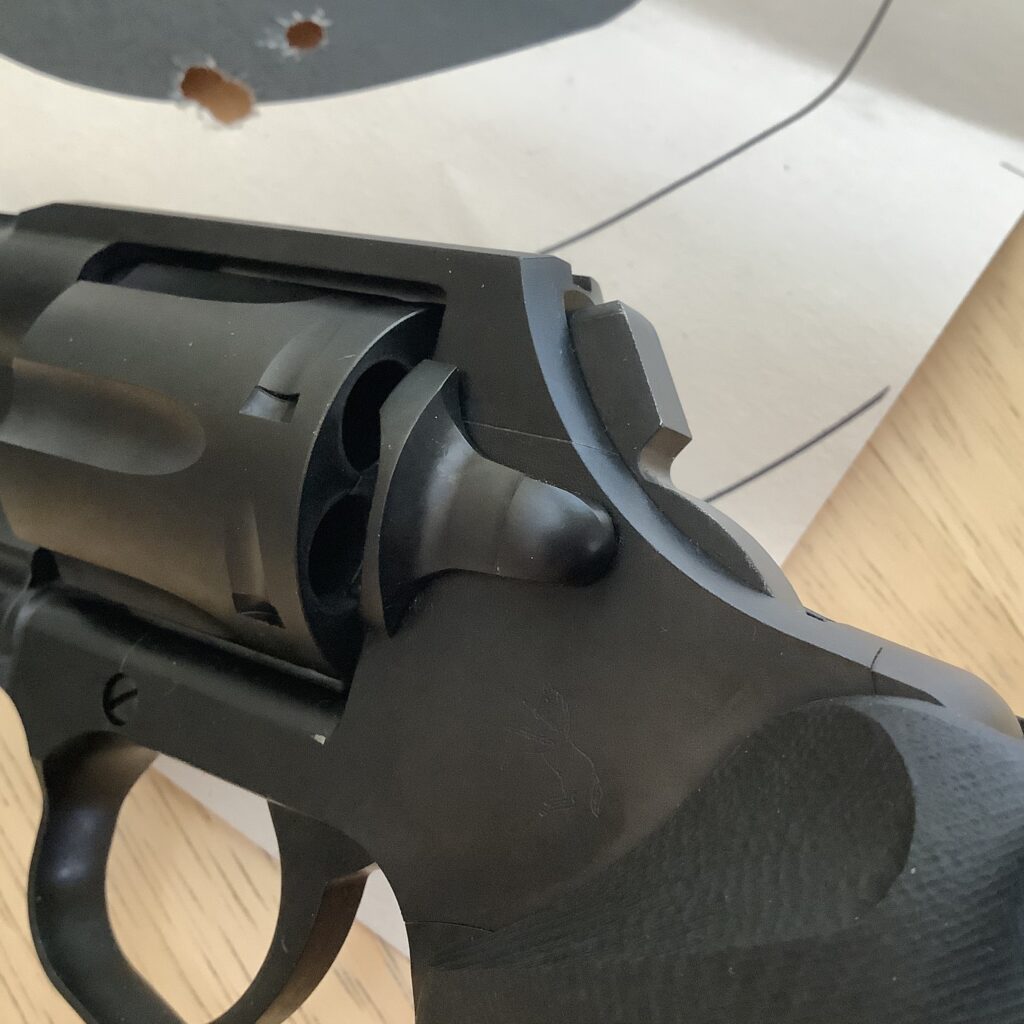
Starting with a baseline new Cobra, Colt bobbed the hammer spur and removed the single action sear to create a true, double action only Cobra. Without a long ear to hook on things, the Night Cobra’s hammer will make the job of getting the gun into action much easier when you draw it from a pocket, or from under a shirt or jacket. There’s a small remnant of the base of the spur on the back of the hammer, which is necessary to give the hammer the requisite weight, and while it has a squarish profile with a blocky corner, I don’t think it’s likely to snag on anything.
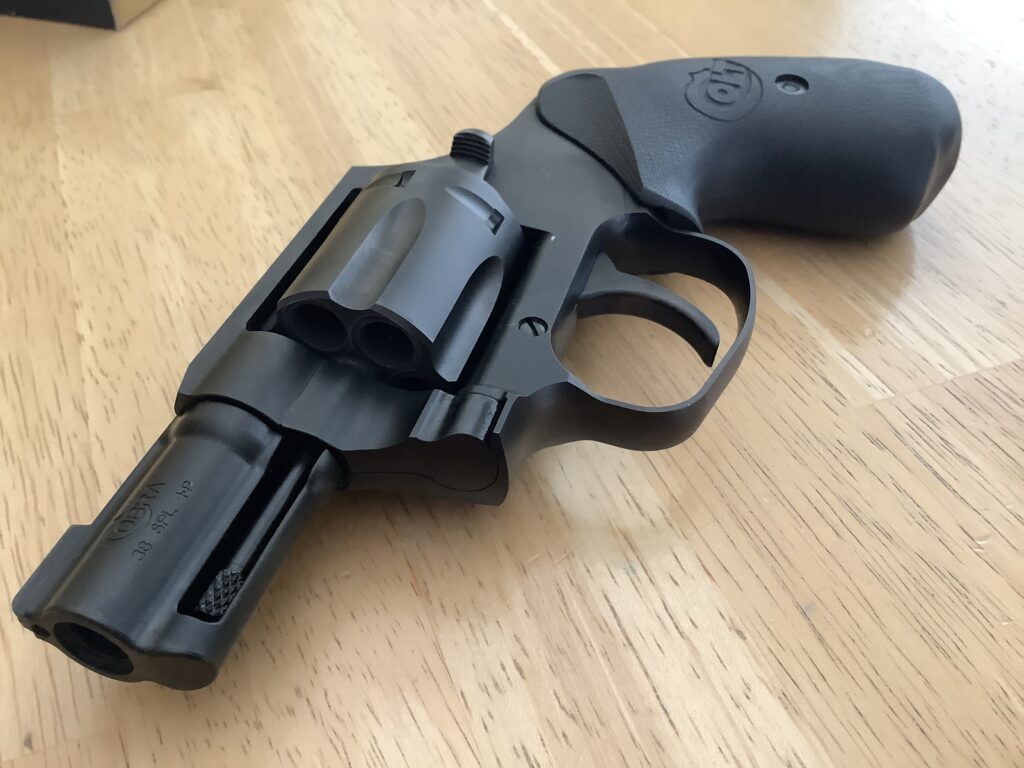
The Night Cobra has a special grip made from G10 that’s smooth and rounded, to provide a handle that won’t grab clothing and cause the gun to print. This rounded, almost bulbous, grip will let even the thinnest of cover garments slide right off, and even if the gun does print, it won’t have that blocky, squared shape that screams “gun!” These grips are made by VZ Grips, for those who may want to put them on their own Cobra.
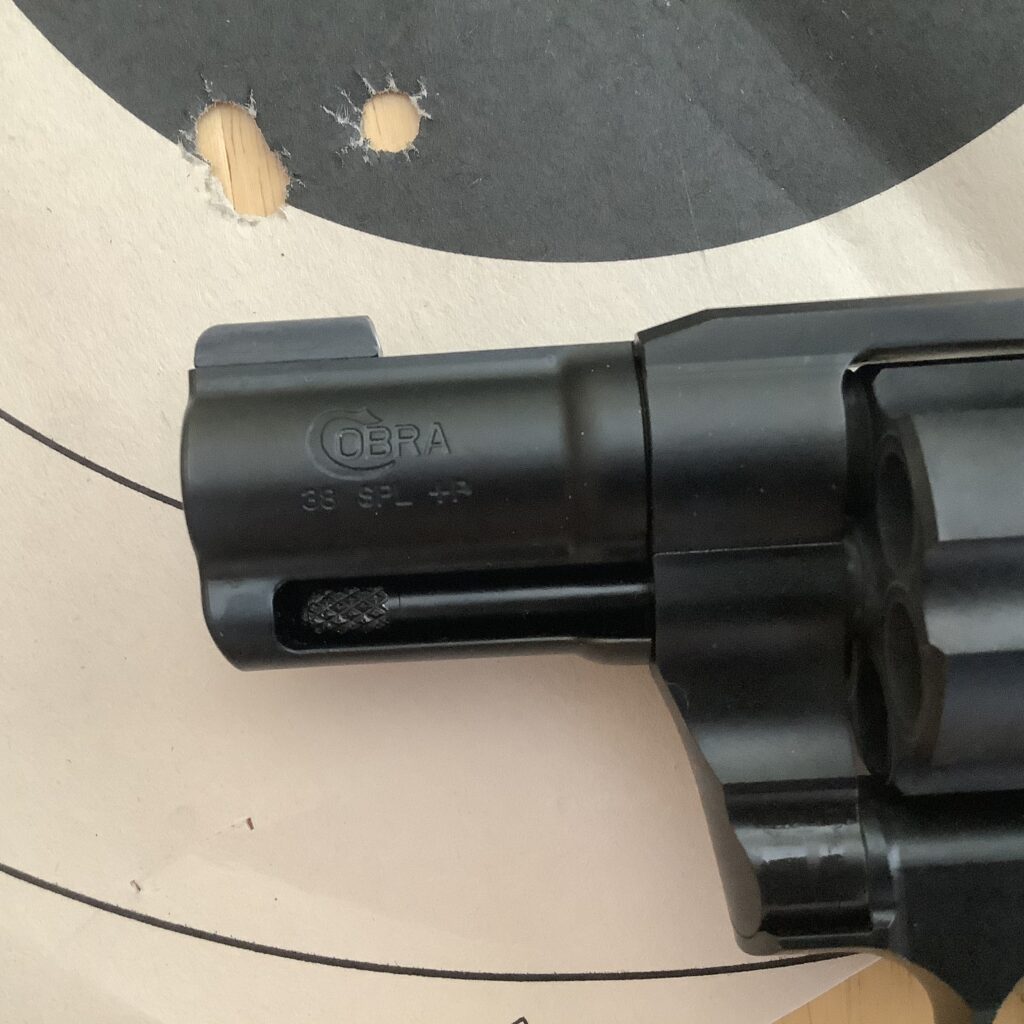
Up front, Colt took advantage of their foresight (pun intended) and replaced the front blade of the Cobra with a night sight featuring a green globe for nocturnal use, and a white outline for daytime. The rear sight is unchanged on the Night Cobra, and lacks the additional lamps that we often see on a pistol wearing night sights, but I’m glad to see it that way. I prefer having a night sight up front and a plain rear sight, since I think it keeps the sight picture uncluttered and helps to keep your focus on the front, where it belongs. It would have been more expensive for Colt to mill a dovetail on the rear of the frame and include a tritium-powered rear sight, and I think it would have degraded the sight picture, so I’m glad to see they went the route they did.
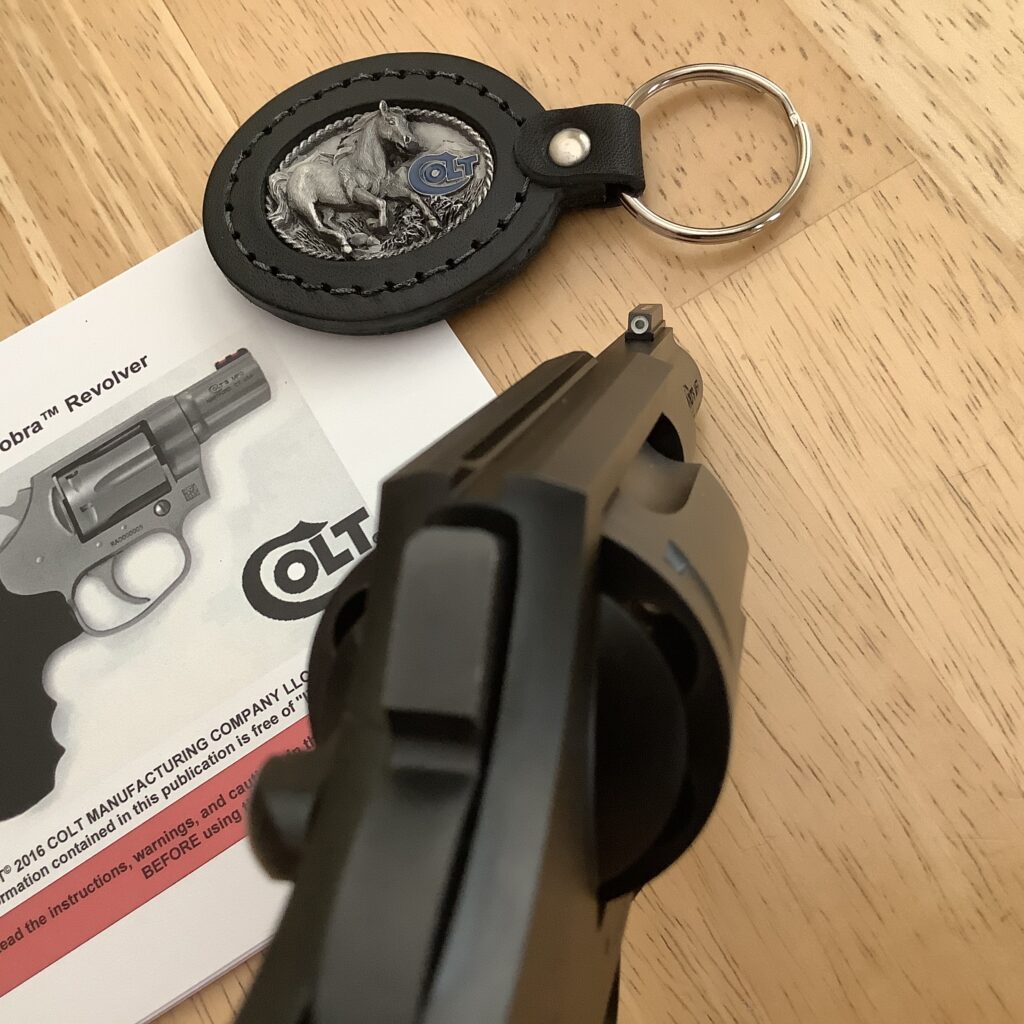
The most remarkable thing about the sights on the Night Cobra is that they’re well-regulated. As you’ll see in the targets below, they did a good job of putting the bullets on target at the right elevation. This is something that was missing in the gun’s closest competition, the Kimber K6s DC, which placed its rounds significantly below the point of aim.
The final touch on the Night Cobra is the matte black, diamond-like coating (DLC) that adds both abrasion and corrosion resistance, and a serious look to the gun. It does a nice job of reducing glare as well, making it easier to sight the gun in full sunlight.
Shots fired
The Night Cobra felt great in the hand and I really liked the smooth trigger pull . . . in dryfire. Unfortunately, I wasn’t able to translate that into a performance I was happy with when it came time to actually send lead downrange.
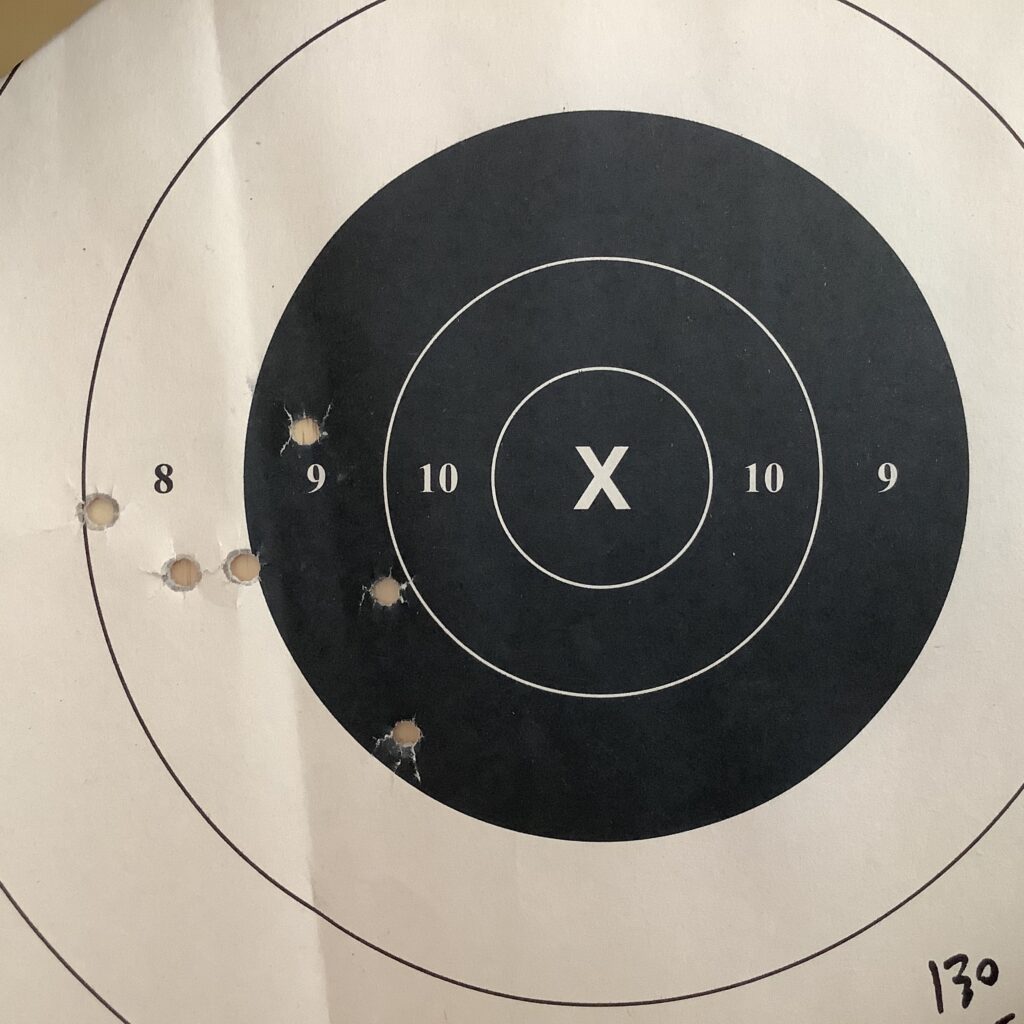
As you’ll see in the test targets, I really struggled with azimuth issues when shooting the Night Cobra. I consistently placed my groups left of center, despite my attempts to correct the error with changes in my grip, trigger finger placement, and trigger pull. The group sizes were reasonable-to-good for a snubby, but I just kept pulling them left, over the course of several months’ worth of shooting.
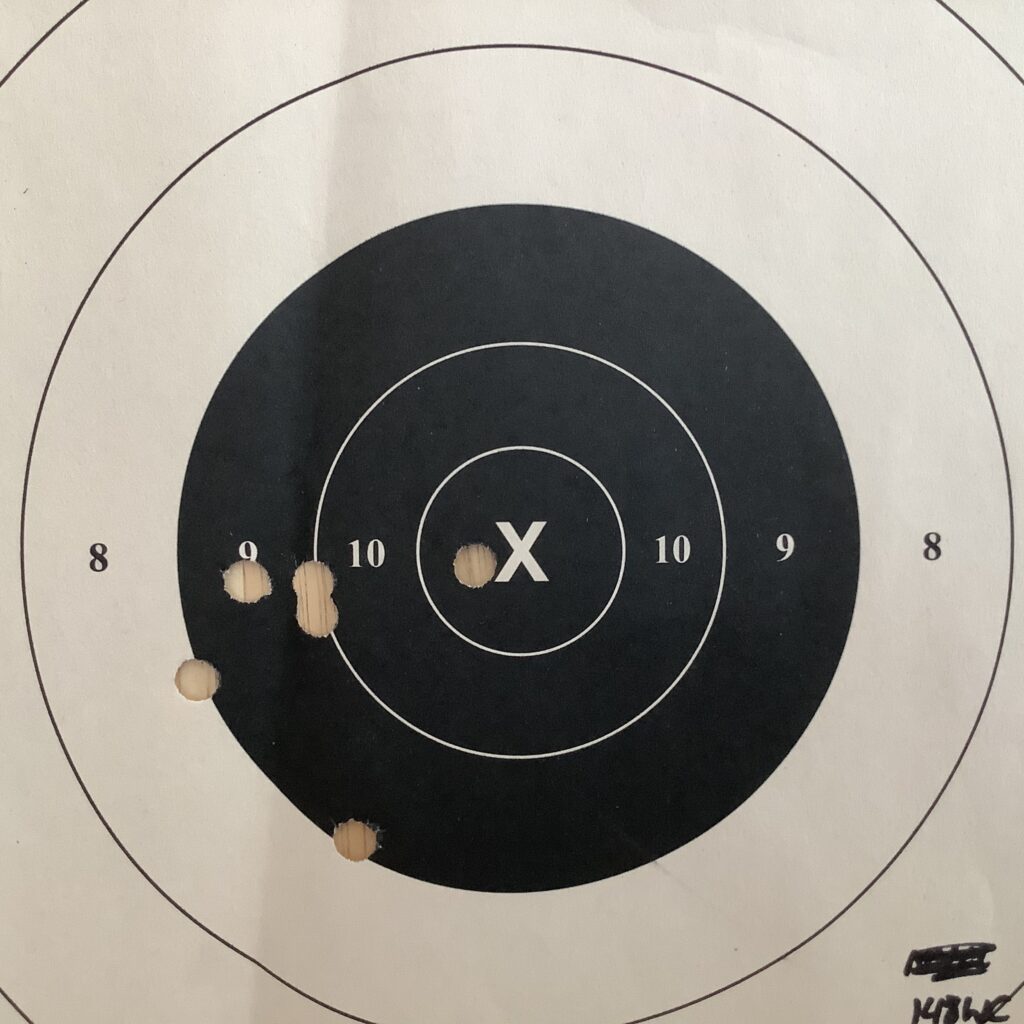
At one point, I thought I’d narrowed down the problem to the grips. The G10 stocks on the Night Cobra feel good, but the bulbous shape makes it slightly difficult to center the gun in your hand, as there’s no easily-detectable centerline. RevolverGuy Dean Caputo once observed that a similar set of grips from another maker made indexing the gun “like trying to aim a lime,” and these felt the same way to me.
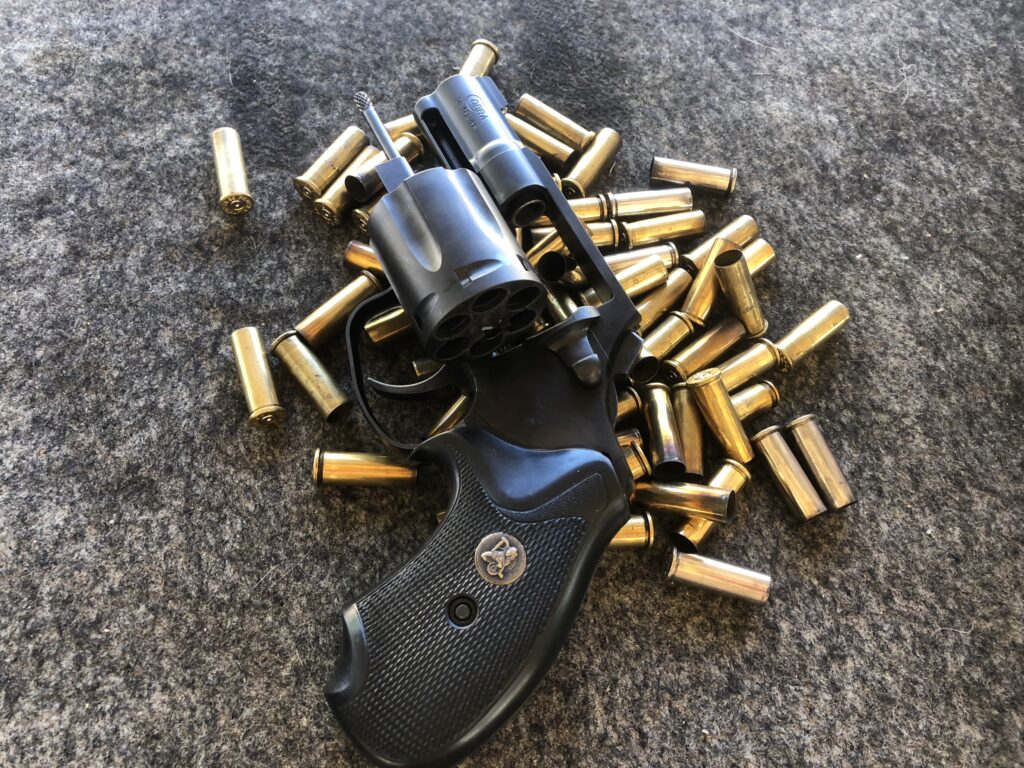
I bought a set of old-production Pachmayr Compacs for the D-Frame, and thanks to the closed backstrap, they were a good fit for the new Cobra (because the heel on the new Cobra’s frame is shaped differently than the old style, an open backstrap grip won’t work very well, but the closed backstrap designs work nicely). Unfortunately, while the new grips made the gun index better for me, they didn’t fix the azimuth errors.
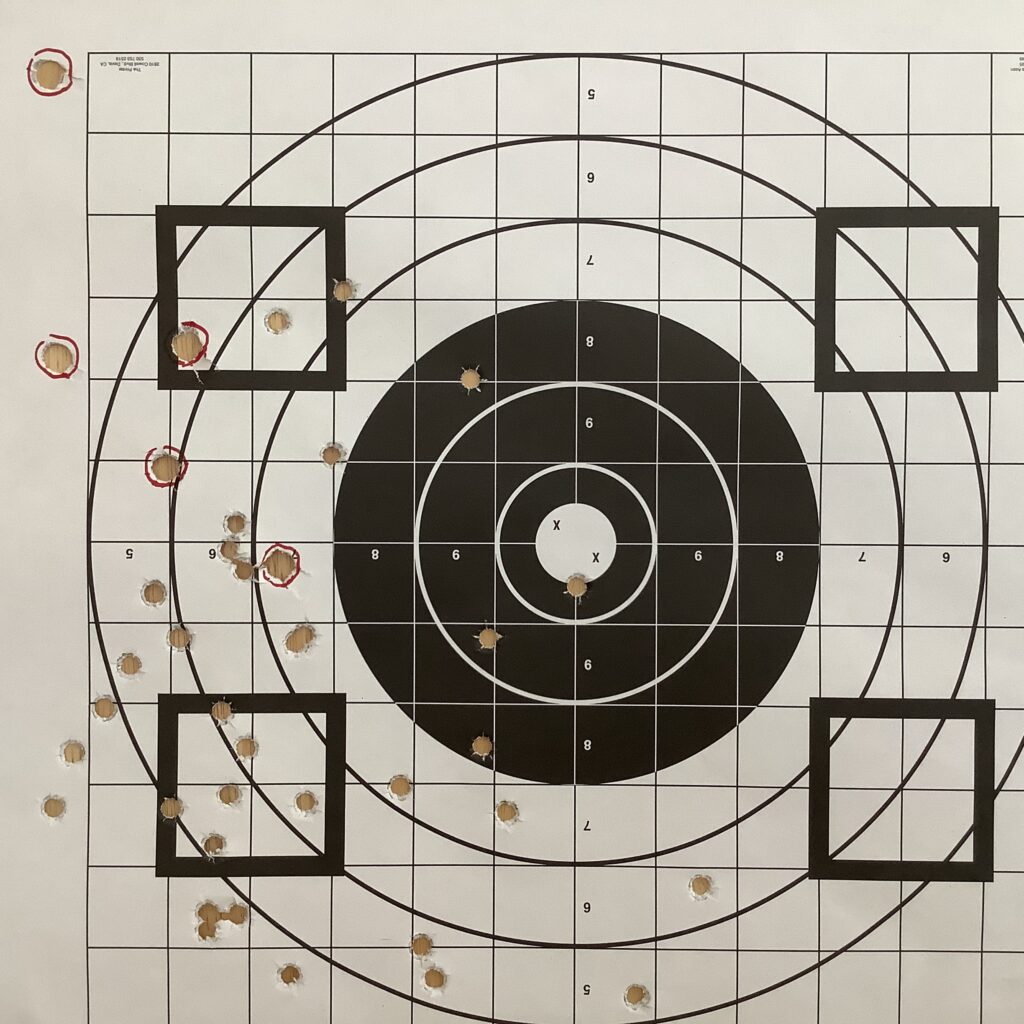
It’s hard to say for sure, but I think my problem may have been related to the shape of the trigger blade. As Justin noted previously in his review of the King Cobra, the face of the Night Cobra’s trigger is pretty narrow and has rather square edges. This results in a lot of pressure being focused on a very small area, and your finger can get sore pretty quickly—not only from operating it, but from the trigger striking your finger during recoil and reset.
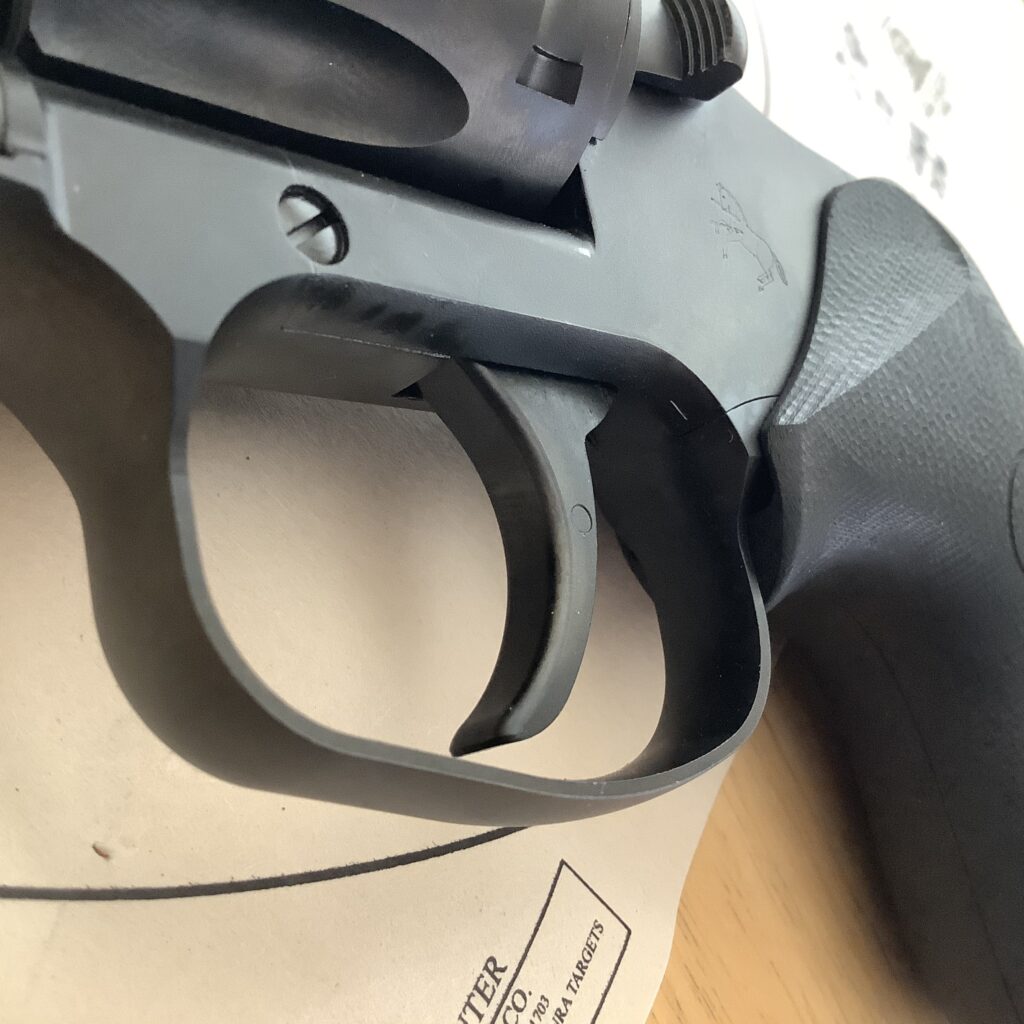
This was a particular problem for me for two reasons. First, I have long and thin fingers without a lot of padding, and second, I like to shoot a double action trigger with the distal crease of the finger centered on the face of the trigger. The squared and narrow Night Cobra trigger simply wasn’t comfortable for me to shoot at the crease, so I changed to the pad of my finger for comfort, and I think–despite my conscious and concerted attempts to avoid it–I may have pushed the gun left as I worked the trigger. It’s the only explanation I can come up with.
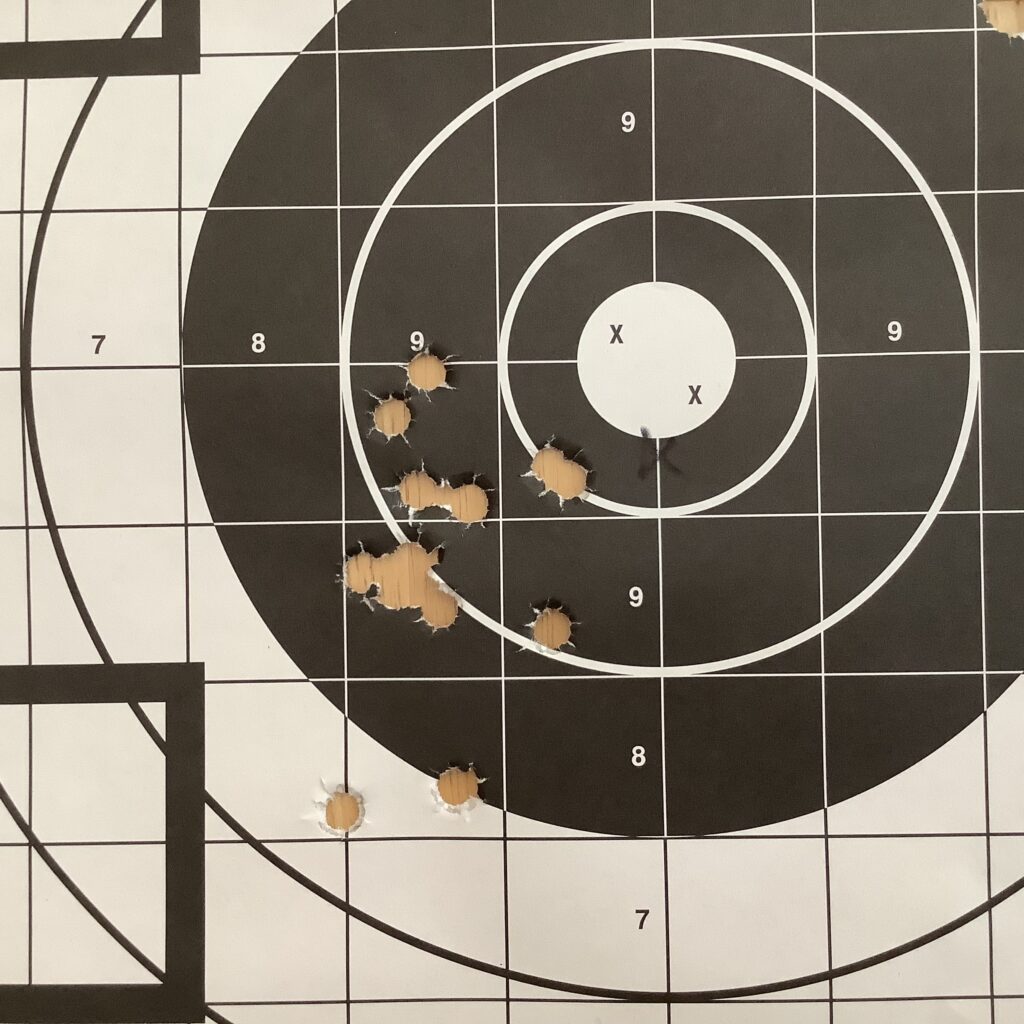
I should note that my prior Colt revolver experience is almost entirely limited to shooting the Python. I owned one of the original .357 Magnum King Cobras for a brief period in the late 80s / early 90s (I sold it after two return trips to a factory warranty station couldn’t fix a nagging misfire problem with a few of the chambers), and had shot a few cylinders through Detective Specials and Police Positives over the years, but that’s the sum of my shooting experience with Colts beyond the Python.
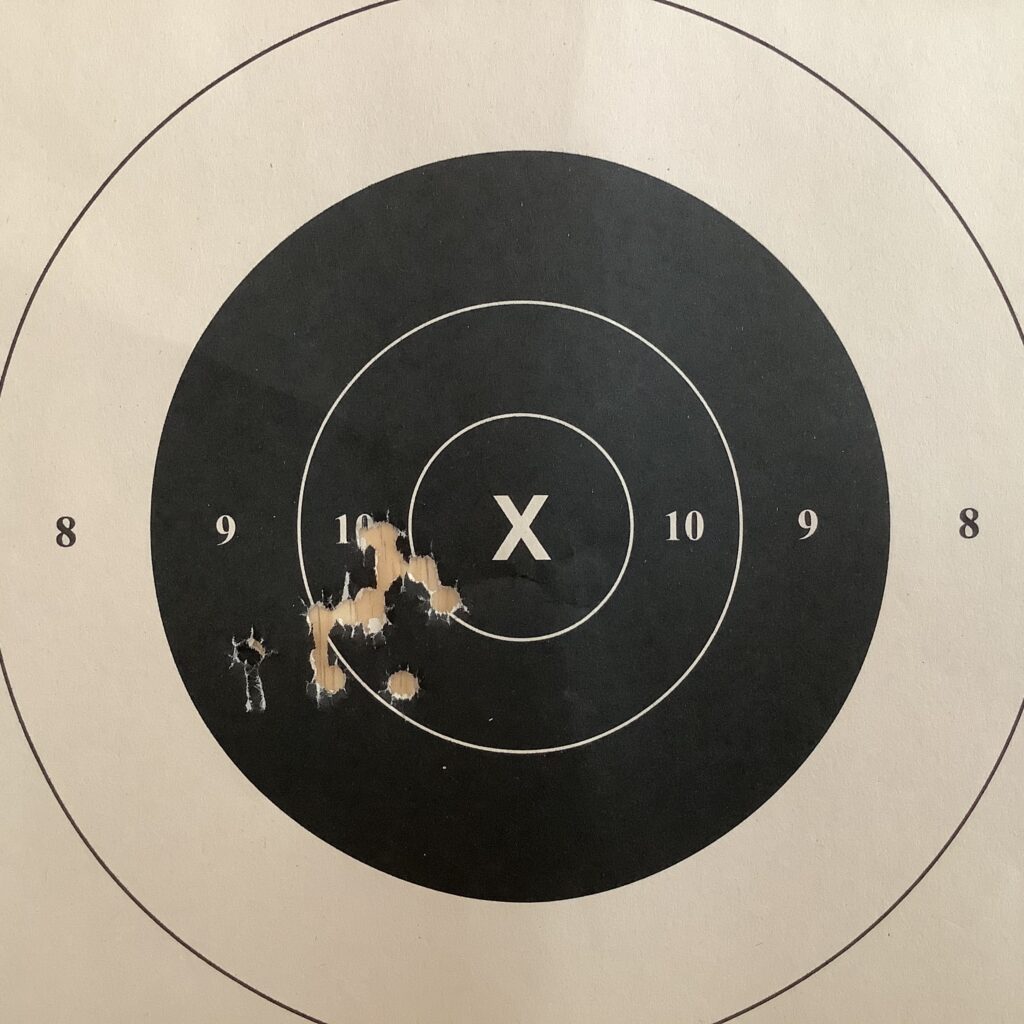
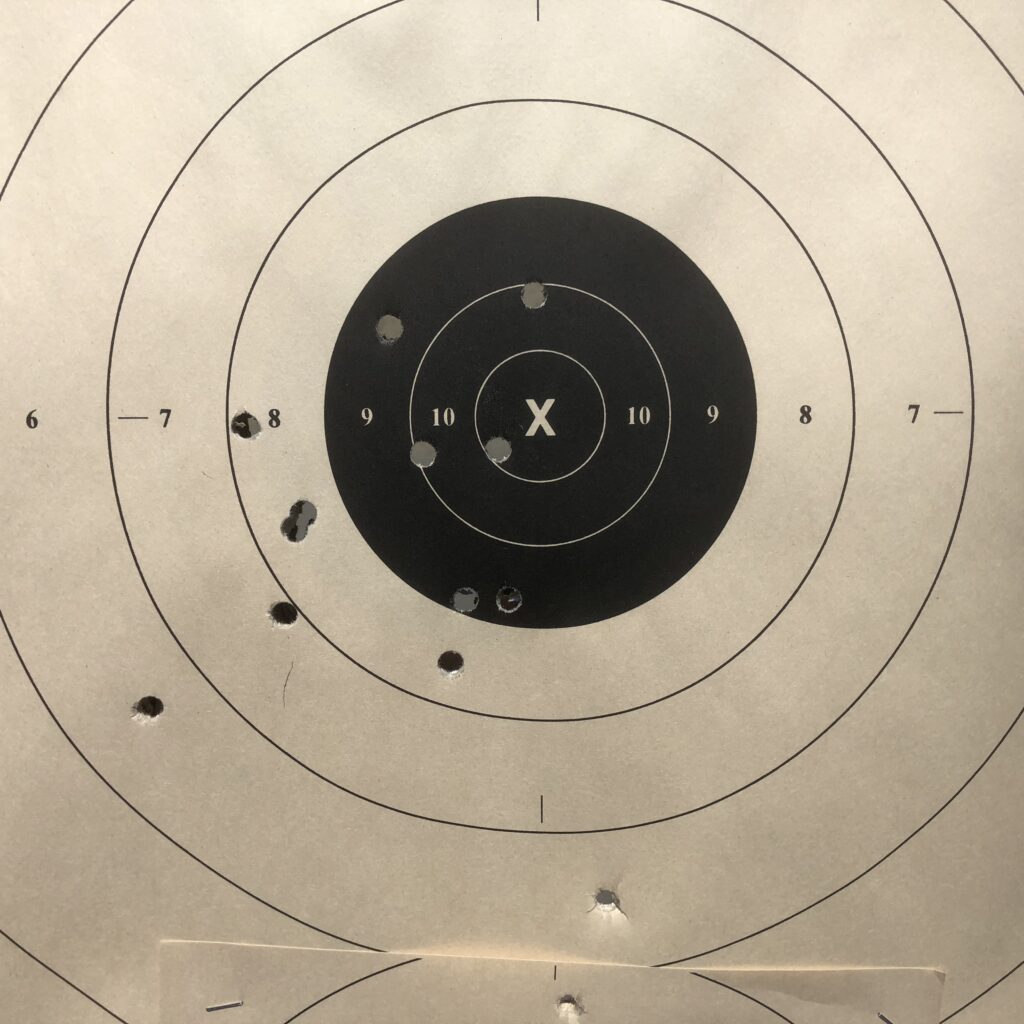
One could speculate that I simply wasn’t used to the stacking trigger on the Colts, and that’s why I had the problem with the Night Cobra, but I don’t think that’s it. The Python has a very “Coltish” stacking trigger, which doesn’t feel at all like the more familiar Smith & Wesson action, yet I have no problems with shooting the Python to the left. I think the wider, target trigger on the Python is the key, here. It’s comfortable for me to shoot the Python at the crease, like I’m accustomed to, with that wider trigger, and the .41-caliber frame of the larger gun also fits my big hands much better than the compact frame of the Night Cobra.
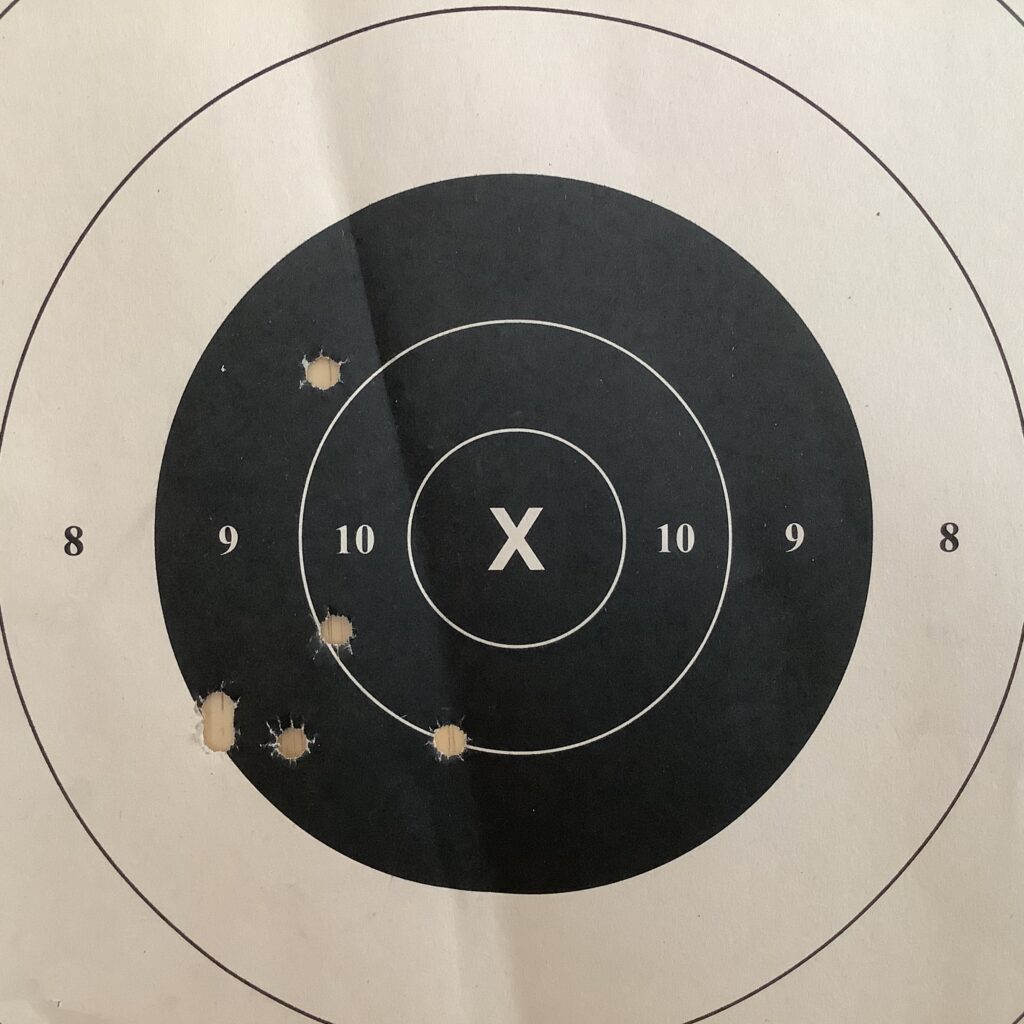
Tellingly, I encountered the same problem of shooting left with the Ruger LCR in .38 Special that I was concurrently testing with the Colt. The Ruger LCR also has a trigger that’s too narrow and sharp-edged for my tastes, and I threw my shots to the left with that gun as well. When I switched to my S&W 640 for a few cylinders to prove I could still shoot straight with a snubby (I could!), the wider, rounded trigger on that gun felt almost therapeutic in comparison to the others.
All in all, I thought the action on the Night Cobra was pretty darned good for a production gun (in terms of smoothness, weight, and trigger return–which was more robust than the sluggish LCR), but I think Colt could really improve the handling on all of the Cobra family guns by giving us a wider blade, with a gently rounded face and rounded edges.
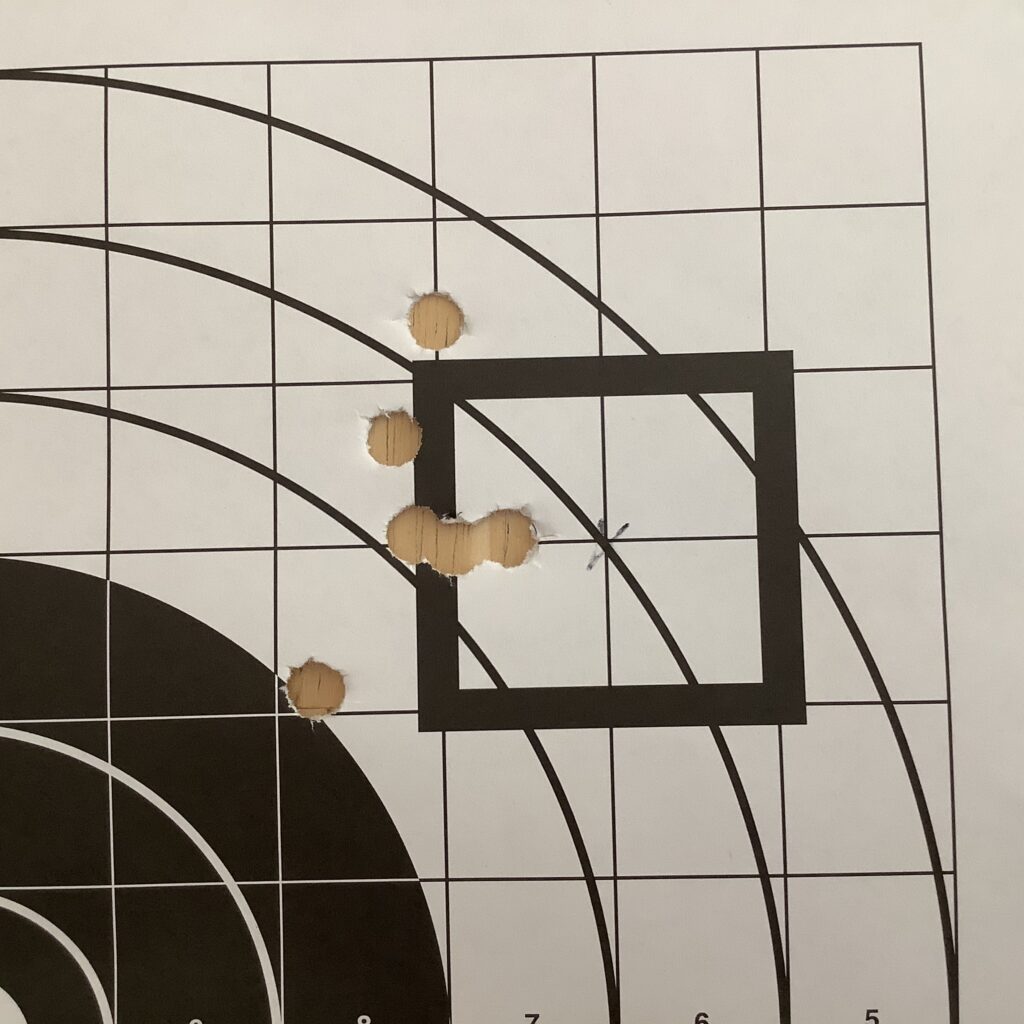
In case you’re wondering, the Colt-style latch worked wonderfully to unlock the cylinder, and the ejector rod worked nicely to clear the old brass out of the gun. I didn’t experience any issues with the ejector rod sticking in after smacking it, as Justin and others have reported after extended use. Perhaps if I’d put more mileage on the gun this would have popped up, but I only sent a little over 300 rounds through the Night Cobra during my testing.
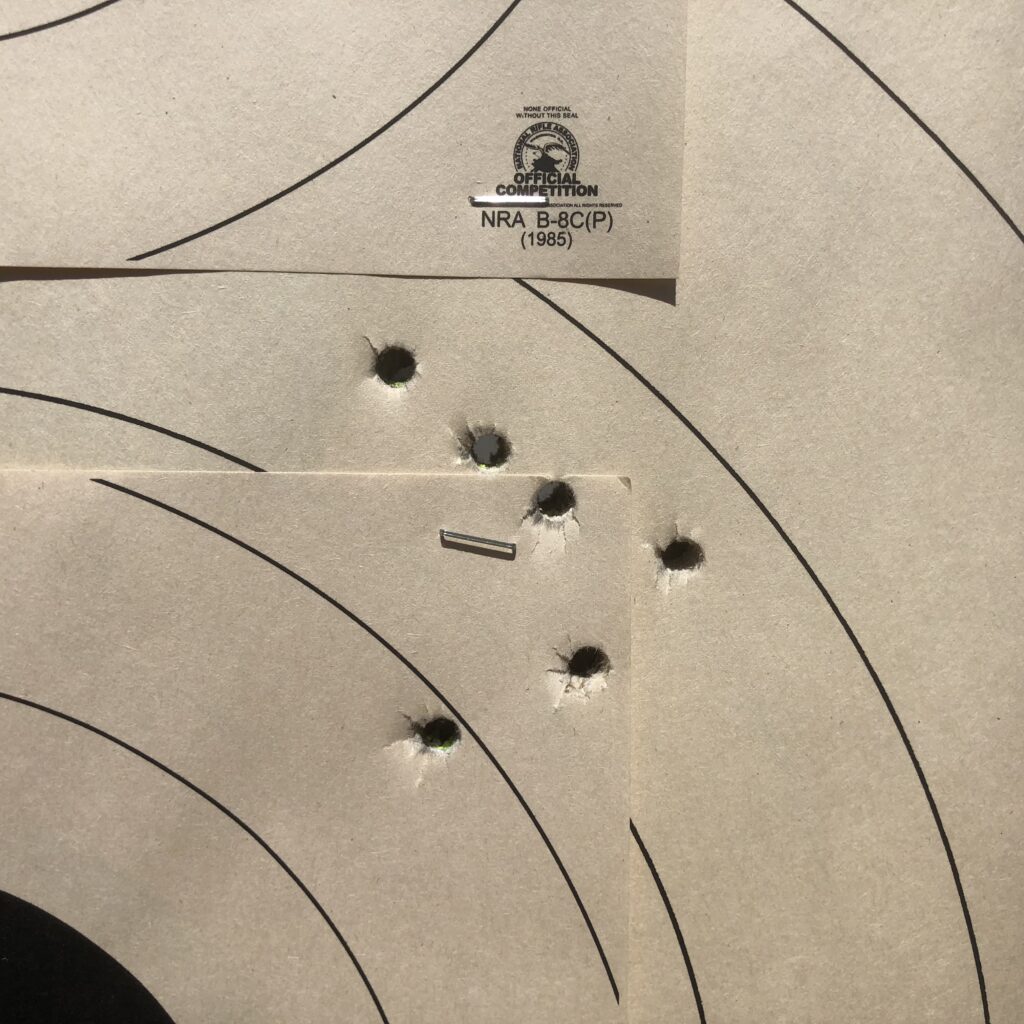
One thing I’ll heartily praise Colt for is the excellent job they did with regulating the sights on this gun. I fired 125, 130, 148 and 158 grain loads through the Colt at ranges from 5 to 25 yards, and it did a fine job of putting them where they belonged, elevation-wise. Some shot closer to point of aim than others at various distances, but they were all pretty close, across the course. This is no mean feat these days, as I’m frequently disappointed by sight regulation issues on new guns. Well done, Colt!
Competition
The Night Cobra’s most direct competitor is the Kimber K6s DC, previously reviewed here in these pages. Like the Night Cobra, the K6s DC has a 6-shot cylinder, night sights, custom G10 grips, and a matte black DLC finish. Because the K6s started as a hammerless design, there was no need to bob a hammer spur, as on the Colt.
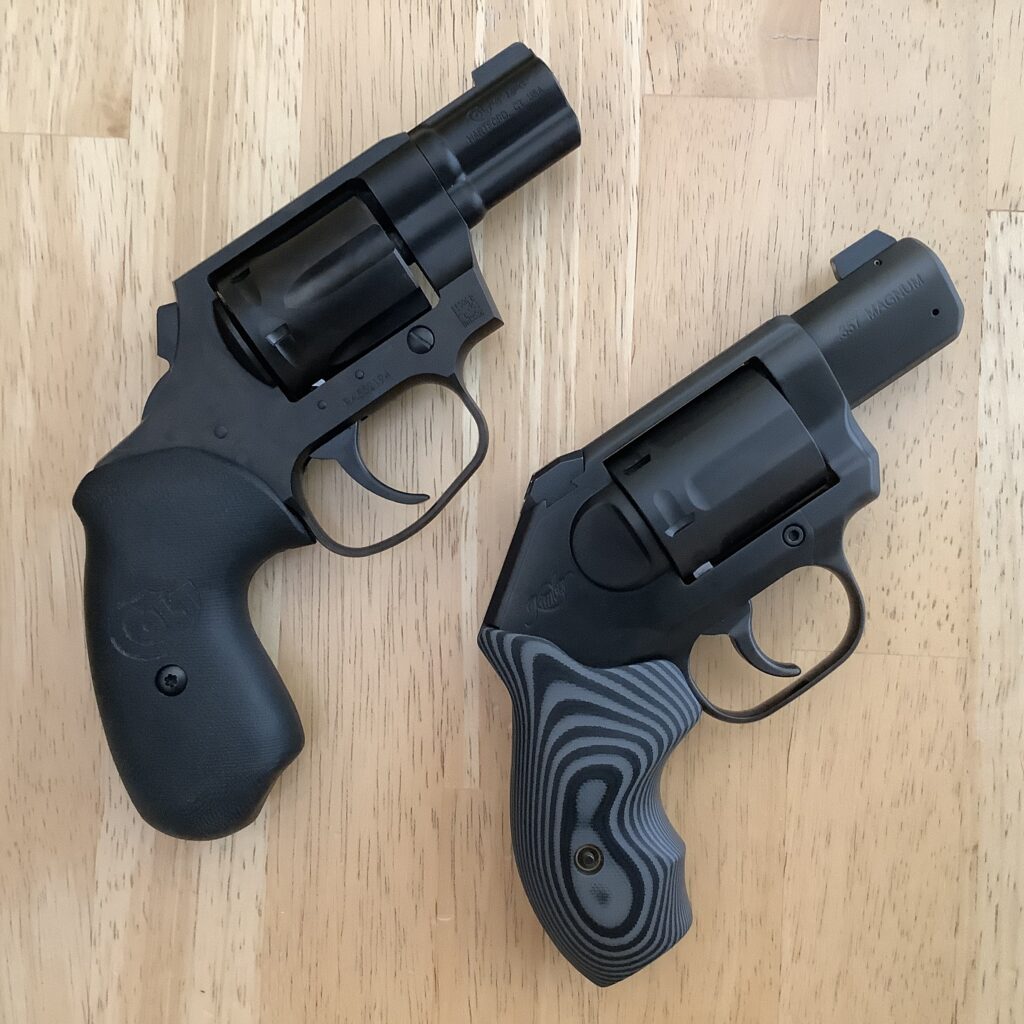
The Colt compares very favorably to the Kimber. It’s slightly longer (0.63” overall) and heavier (about 2 ounces), but definitely belongs in the same size and weight class. The Night Cobra grips are extra long, and extend well below the frame, but if you put a boot grip on it, it would be very close to the Kimber in height.
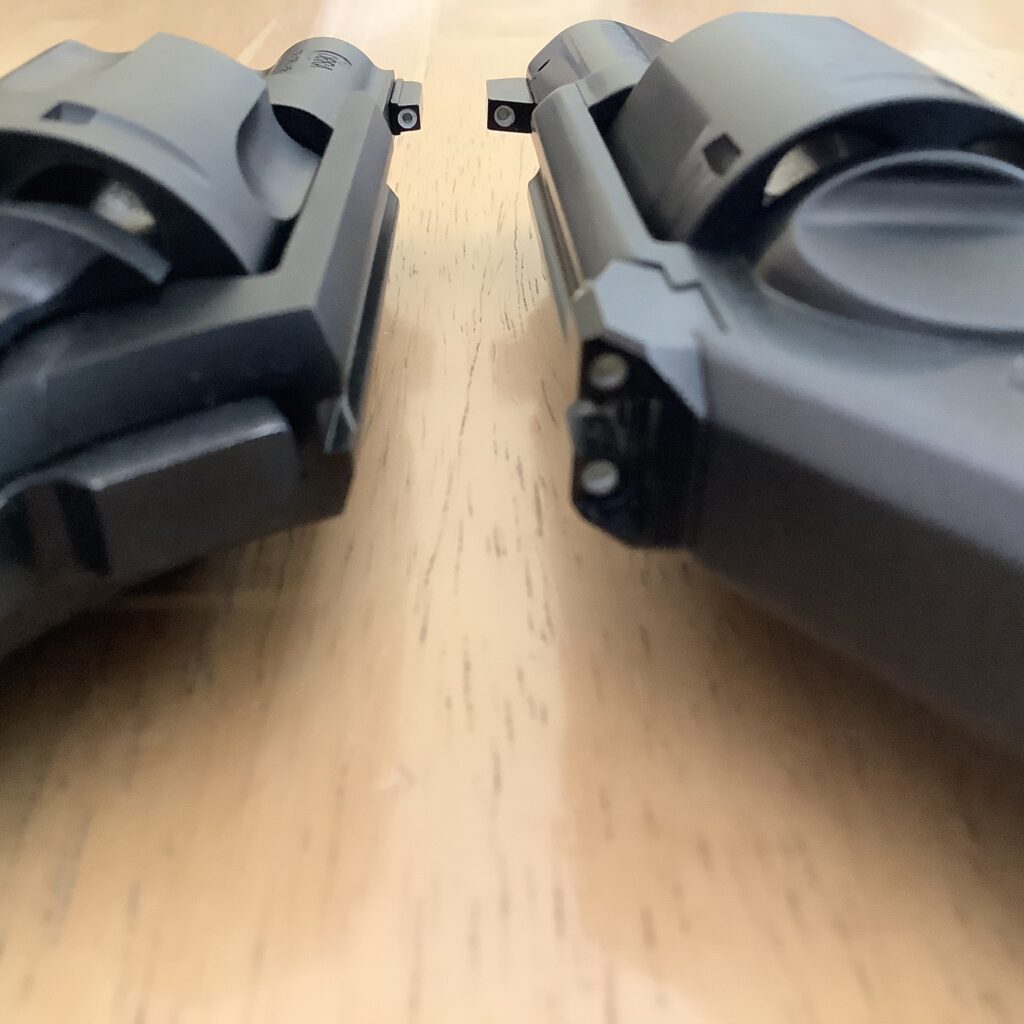
As previously mentioned, the Night Cobra’s sights are well regulated, which places it ahead of the Kimber. The K6s DC has a dovetailed rear sight that the Night Cobra lacks, which gives it an enviable sight picture, but I’ll take the Colt’s less sophisticated rear if it means that my gun won’t shoot in the dirt. When I stretched the K6s DC out to 25 yards in my previous testing, it was printing 8 to 13 inches below the point of aim with 158 grain loads, but the Colt put them right on elevation. It also did that at the closer ranges with loads ranging from 110 grains to 158 grains. Bravo, Colt.
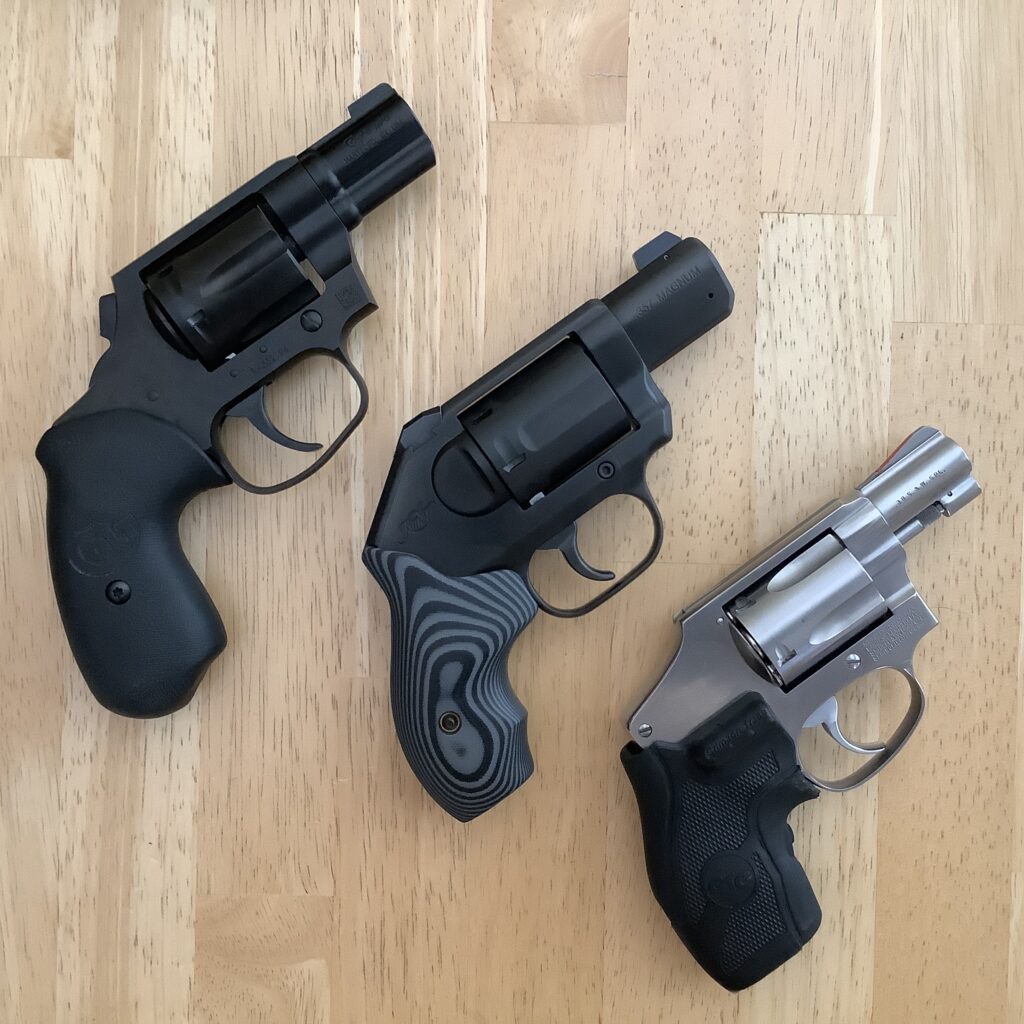
The Kimber’s action is patterned after the S&W design, and frankly, I shot it much better than I did the Colt, notwithstanding the sight regulation issues on the Kimber. Once again though, your experience may differ.
One area where the Colt is a clear winner is the MSRP, which is currently about $256 less than the competing Kimber revolver. That buys a whole lot of ammunition . . . well, it would have, before the latest run on guns & ammo.
Wrap up
Although I didn’t do my best work with it, I was impressed with the Night Cobra and consider it to be a very nice gun. If you’re in the market for a snubby with upgrades, you should definitely put this one on your list to examine and shoot.
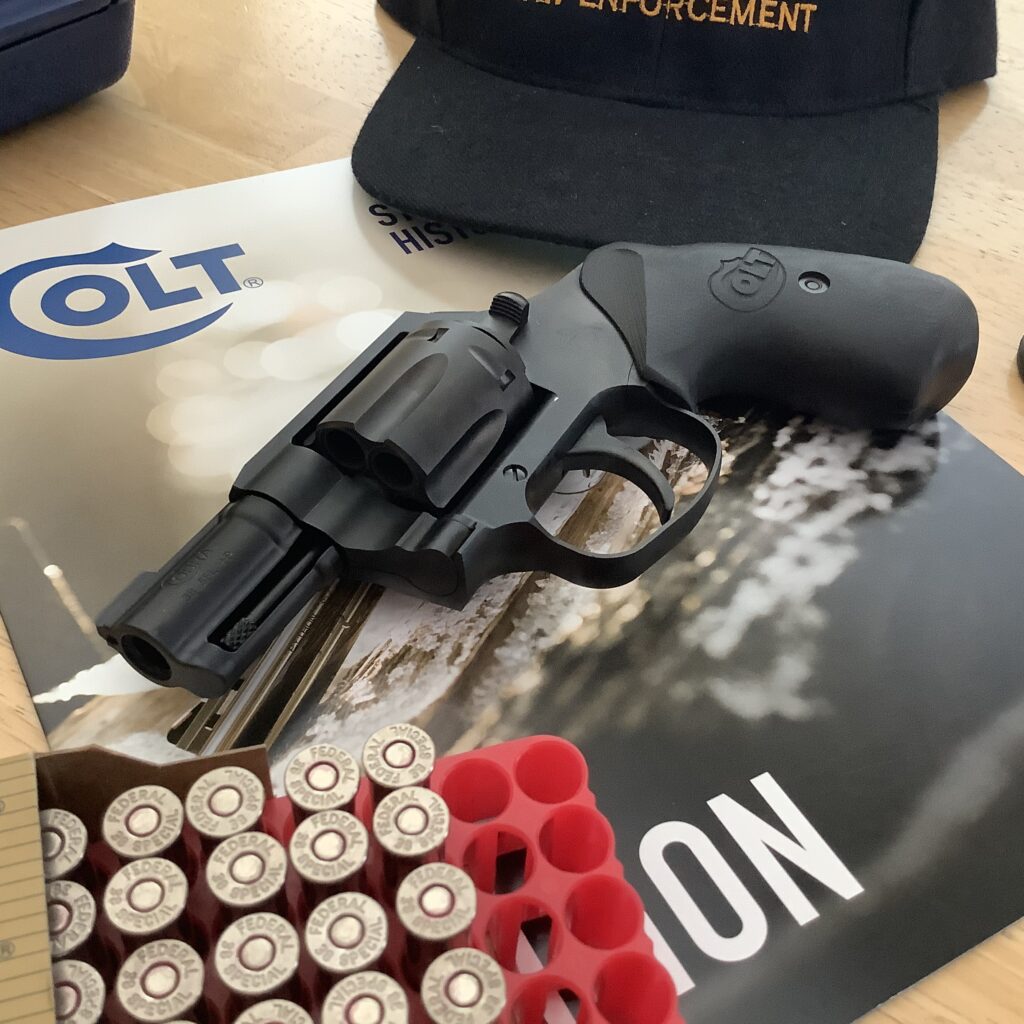
A couple people who fired my sample were also very impressed with the gun, and commented favorably on the “excellent trigger.” One of my good friends was immediately impressed with the Night Cobra when he picked it up for the first time, exclaiming, “Wow! You can tell this is a quality gun.”
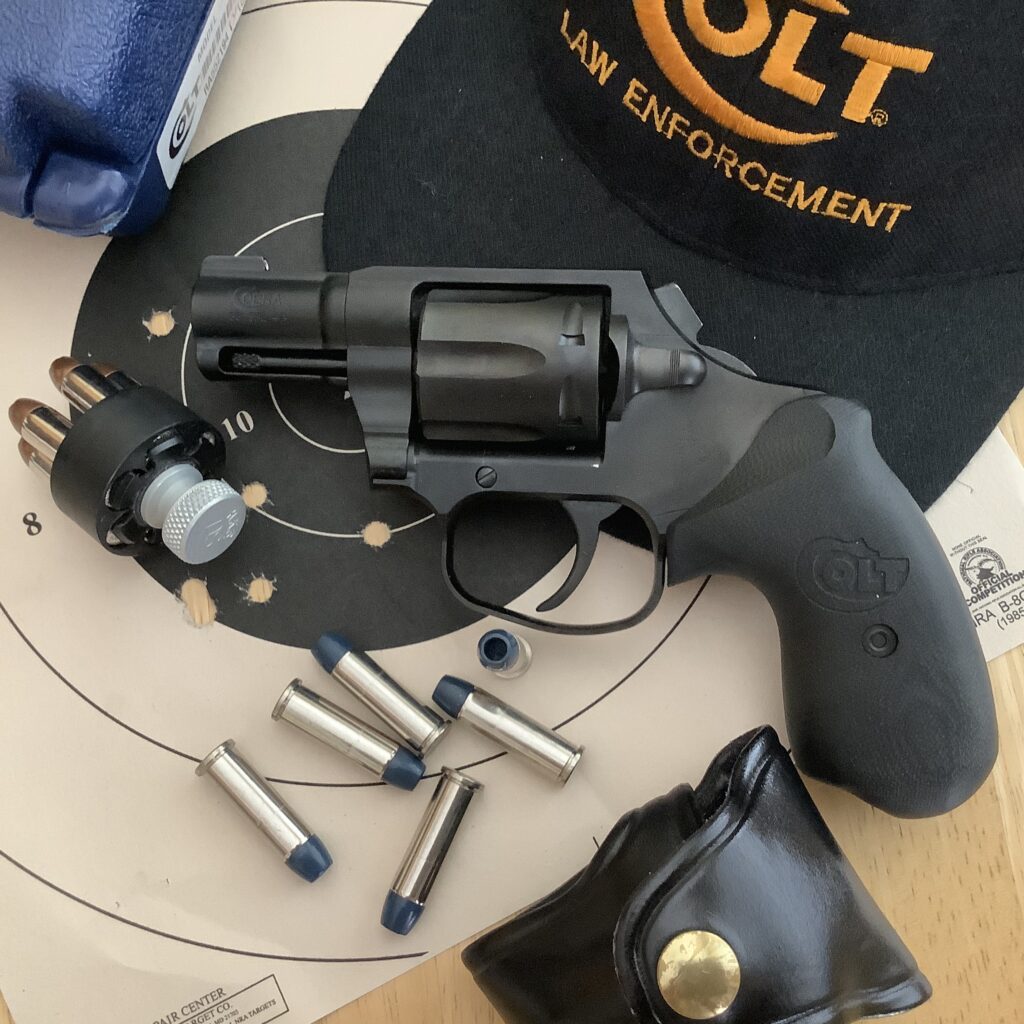
They’re right. The Colt Night Cobra is a quality gun, and it does have an excellent feeling action. My inability to make the gun perform as I wanted it to is not an indictment of the gun, but rather an indicator that we just weren’t compatible for some reason. In that sense, the Night Cobra is like some of the girls that I’ve known—I liked them a lot, but we weren’t a good match.
So, don’t let my frustrating experience with the Night Cobra temper your interest in this fine gun. Stick it in your own hand and see how it does with a different “trigger actuator.” I think you’ll be pleased . . . especially if you’ve got better padding on your fingers than I do!
*****
I’d like to thank RevolverGuys SHBond 357 and Dean Caputo for helping me to unravel the mysteries of Colt actions. Thanks guys, for the education!
NOTES:
1. RANT ALERT! Please allow an old soul a curmudgeonly moment, here. This practice of recycling classic names really stews me, and I wish all the Marketing people in these gun companies would stop this nonsense. Words mean something, and slapping a classic name on a new product seems an awful lot like revisionist history to me, so I heartily disapprove. When I talk about a “Military & Police,” a “Cobra,” or a “Security,” I’d like to be able to do that without having to add an asterisk or other qualifier so you know what I mean. I suppose the Marketing types think there’s value in tapping into the sentiments stirred by favorite old marques, but nobody I know who remembers the old products seems to approve of this practice, and the younger customers who don’t know any better would be just as well served by a fresh, new name. Besides the offense to propriety, it makes it awfully laborious to accurately describe what you’re talking about. If I’m talking about a “Military & Police” as a double action K-Frame revolver, and you’re thinking about an AR-15 rifle or a plastic squirt gun, then we’re not communicating. Similarly, if I’m referencing a “King Cobra” as a Medium-Large .357 revolver and you’re thinking about a small frame one with a shorter tube, then we’ve got a problem . . . especially if one of us is a grip or holster maker! Marketers: Stop this please! If you can’t come up with a creative and flashy name for a new product, please find someone who can. If none of the kids around the water cooler have an idea, you can start with us old farts who still have a worn, hardback, dictionary on the shelf, and an imagination. Please and thank you. Fudd Rant Over & Out! ; ^ )
2. Honestly, the Cobra lineage was confusing enough as it was, before Colt added the 2017 model. Like the Detective Special it was modeled on, the Cobra’s grip frame changed midstream, in 1966, to a shorter butt that mirrored the smaller Agent’s. Prior to that, the grip frame was longer, and could be found in both square (early) and round (later) butt versions, but after 1966, only the short and square (Agent-like) profile was manufactured. Grip makers everywhere cursed the change, since it complicated fitting these guns with the proper panels, and required them to post special notices for unwitting customers to avoid complaints and returns. The 2017 Cobra’s grip frame is slightly more rounded at the heel, creating yet another headache for grip makers, who have to differentiate it from the post-1966 Cobras, to ensure the proper fit. What a mess!

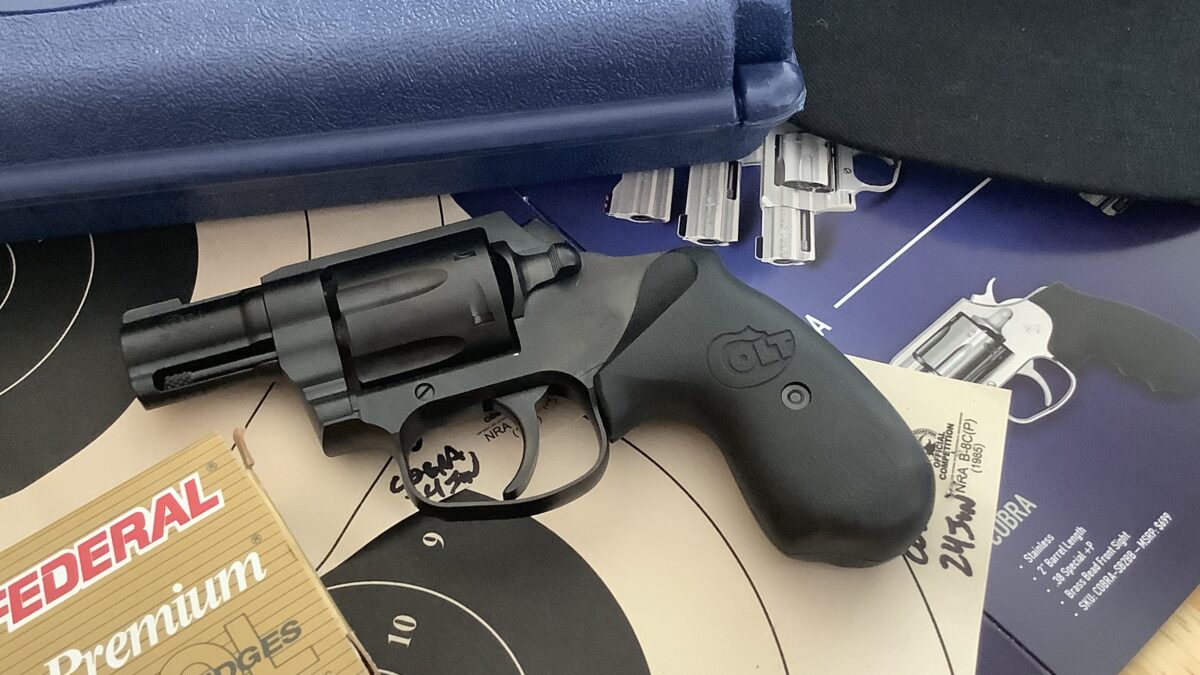
The detailed reporting on the hammer, trigger,
stacking, lack of lockup before hammer fall,
possible resultant timing issue,
the stocks all convince me I wouldn’t want
one.
Hope I didn’t steer you wrong. The cylinder DOES lock up, but it just does it late in the firing cycle, compared to S&W or Ruger. You’ll find the same thing with all Colts, including the vaunted Python, along with the stacking, the hand wear, etc…it’s just the Colt system.
Some love it, some don’t, and some don’t mind either way. The stacking on a Colt action doesn’t bother me, and I find that the newest Colts all have good feeling, smooth actions. I was particularly smitten by the new 2020 Python, which was really smooth and light at the SHOT Show (I gather the action is now a few pounds heavier, to cure ignition issues with some hard primers, but I’m sure it’s still quite pleasant).
The narrow, square trigger on the Cobra has to go, though.
Informative and entertaining article, as always, but, like you, I’m not fond of recycling names. I have a “military and police” k-frame and a m&p shield, and it gets tedious clarifying to the semi auto generation that I mean a revolver when I say military and police. The semi auto is easier because I just say “Shield”.
Keep up the great work.
Thanks Jim! I’m glad I’m not alone in my opinion on the recycled names. What a pain!
I too rail at re using the same names… and Hollywood recycling old movies for that matter! Get a fresh idea people!
Mike, thanks for a great review! I always look forward to new articles on here.
Thanks Joe, I really appreciate that!
I have owned a Night Cobra for about a year when I got one on Gunbroker new for $560. It shoots just a hair to right of point of aim for me at 15 yds. A hair in this case is less than 2″. It’s been utterly reliable, very accurate and the night sight is easy to pick up in darkness. I shoot a hot full wadcutter in it for my primary and a Buffalo Bore Non+P 158 grain LSWCHP as reloads, both loads do 865 avg out of the NC.
I did change the grip from the VZs to the Hogue made for the New Cobra 2017, which I also own one of. I have shot and carried both Cobras and hate utter confidence in them. Everyone raves about the “old D frames” but I carried D frames as a backup as a LEO for 22 years. The Old D frames were weaker, poorer trigger, and a tougher sight picture. They did look cool though. My old D frames stacked the trigger more, almost without exception shot high(3rd series sight was too short). and +P ammo was frowned upon. They were cool looking though.
Tom, I think the new Cobras are better performers than the older guns, even if they lack a little bit of the flair! I’m glad you’re enjoying yours. By the way, $560 is a steal for a Night Cobra—great job!
The photo of the “new” action looks a LOT like the action in my Magnum Carry. It’s not identical, with a V spring on the hammer of the MC, but close. I hope it doesn’t have the same tendency to develop light strikes. That “frame mounted firing pin” in the MC is not really serviceable, since it is held in by a pressed in piece. Another question only time can answer – will the factory be around to repair problem guns for any reasonable amount of time? They were not around very long after the MC was introduced. By the way, “Magnum Carry” was a great new name, if not very accurate. Serious de-horning was needed to make it comfortable to carry.
You bet, Chris, there are definitely similarities between the MC and New Cobra action. That’s an interesting observation about the firing pin—I don’t have my sample Night Cobra any longer to look at that, but I’d be interested to know. I definitely hope the latest resurrection of Colt will last, and they’ll be around for a long time to service our guns!
Thank you for the review. The Night Cobra was something I was interested in, but the price (and weight for pocket carry in spring/summer) means I’m unlikely to acquire one myself anytime soon.
So can you cook the small hammer and shoot single action?
No, you cannot. There is no single action sear surface.
You don’t mention whether you shot the gun from sandbags or some other type of rest. Is it possible that the sights just aren’t regulated correctly for windage?
It’s possible, John, but it didn’t appear that things were out of whack. I no longer have it to check.
I really enjoyed your review on this gun. I love Colts and I’m hoping to get one of these gems soon.
I enjoyed all the interested reading from my cell phone. I am a diehard revolver guy & definitely a Colt nut. I have 2 Night Cobras, an early model King Cobra and a 2020 Stainless 6inch Python. One Night Cobra & the Python are still in the box in original packaging from gun store.